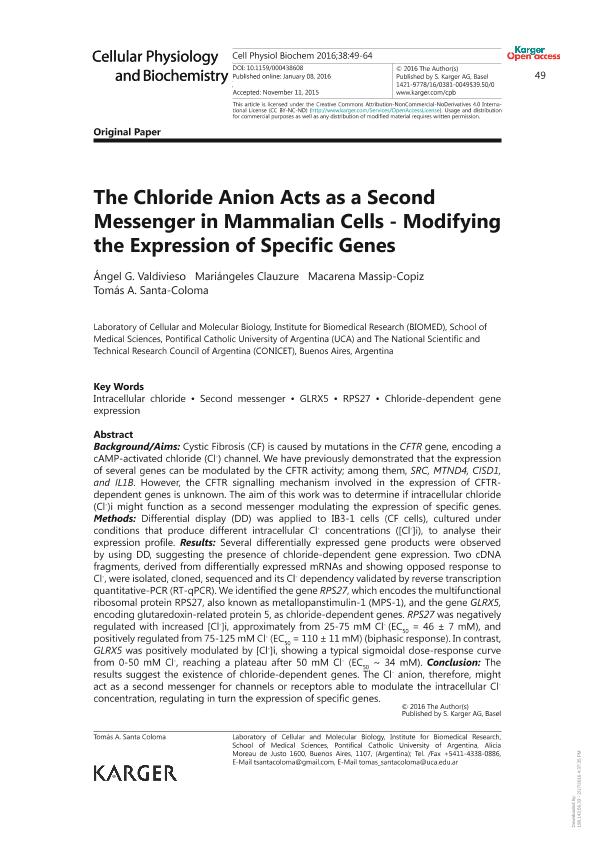Artículo
The Chloride Anion Acts as a Second Messenger in Mammalian Cells: Modifying the Expression of Specific Genes
Valdivieso, Ángel Gabriel ; Clauzure, Mariangeles
; Clauzure, Mariangeles ; Massip Copiz, María Macarena
; Massip Copiz, María Macarena ; Santa Coloma, Tomás Antonio
; Santa Coloma, Tomás Antonio
 ; Clauzure, Mariangeles
; Clauzure, Mariangeles ; Massip Copiz, María Macarena
; Massip Copiz, María Macarena ; Santa Coloma, Tomás Antonio
; Santa Coloma, Tomás Antonio
Fecha de publicación:
01/2016
Editorial:
Karger
Revista:
Cellular Physiology and Biochemistry
ISSN:
1015-8987
Idioma:
Inglés
Tipo de recurso:
Artículo publicado
Clasificación temática:
Resumen
Background/Aims: Cystic Fibrosis (CF) is caused by mutations in the CFTR gene, encoding a cAMP-activated chloride (Cl-) channel. We have previously demonstrated that the expression of several genes can be modulated by the CFTR activity; among them, SRC, MTND4, CISD1, and IL1B. However, the CFTR signalling mechanism involved in the expression of CFTR-dependent genes is unknown. The aim of this work was to determine if intracellular chloride (Cl-)i might function as a second messenger modulating the expression of specific genes. Methods: Differential display (DD) was applied to IB3-1 cells (CF cells), cultured under conditions that produce different intracellular Cl- concentrations ([Cl-]i), to analyse their expression profile. Results: Several differentially expressed gene products were observed by using DD, suggesting the presence of chloride-dependent gene expression. Two cDNA fragments, derived from differentially expressed mRNAs and showing opposed response to Cl-? were isolated, cloned, sequenced and its Cl- dependency validated by reverse transcription quantitative-PCR (RT-qPCR). We identified the gene RPS27, which encodes the multifunctional ribosomal protein RPS27, also known as metallopanstimulin-1 (MPS-1), and the gene GLRX5, encoding glutaredoxin-related protein 5, as chloride-dependent genes. RPS27 was negatively regulated with increased [Cl-]i, approximately from 25-75 mM Cl- (EC50 = 46 ± 7 mM), and positively regulated from 75-125 mM Cl- (EC50 = 110 ± 11 mM) (biphasic response). In contrast, GLRX5 was positively modulated by [Cl-]i, showing a typical sigmoidal dose-response curve from 0-50 mM Cl-, reaching a plateau after 50 mM Cl- (EC50 ∼ 34 mM). Conclusion: The results suggest the existence of chloride-dependent genes. The Cl- anion, therefore, might act as a second messenger for channels or receptors able to modulate the intracellular Cl- concentration, regulating in turn the expression of specific genes.
Palabras clave:
Glrx5
,
Rps27
,
Chloride Dependent-Gene Expression
,
Intracellular Chloride
Archivos asociados
Licencia
Identificadores
Colecciones
Articulos(BIOMED)
Articulos de INSTITUTO DE INVESTIGACIONES BIOMEDICAS
Articulos de INSTITUTO DE INVESTIGACIONES BIOMEDICAS
Articulos(OCA HOUSSAY)
Articulos de OFICINA DE COORDINACION ADMINISTRATIVA HOUSSAY
Articulos de OFICINA DE COORDINACION ADMINISTRATIVA HOUSSAY
Citación
Valdivieso, Ángel Gabriel; Clauzure, Mariangeles; Massip Copiz, María Macarena; Santa Coloma, Tomás Antonio; The Chloride Anion Acts as a Second Messenger in Mammalian Cells: Modifying the Expression of Specific Genes; Karger; Cellular Physiology and Biochemistry; 38; 1; 1-2016; 49-64
Compartir
Altmétricas



